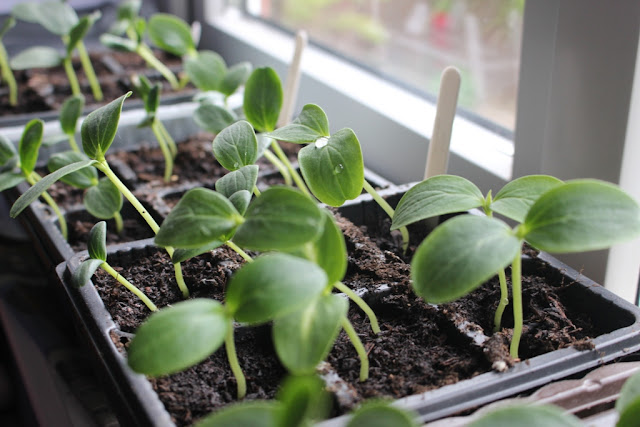Cucurbit trials
Question: Does it matter which way up cucurbit* seeds are sown?
Answer: Have a look at the above photo and guess what my conclusion might be. Some references say sow them on their side - which is the way I usually do - others are non-committal.
I couldn't find any reason why they should be sown on their side, so I decided to conduct a quick trial. Luckily my seed stash had some packets to spare, yielding 44 cucumber, 24 squash and 8 courgette seeds, 76 all told.
I sowed the seeds in four different ways: sideways, flat, upright ("pointy" side of the seed uppermost) and upside down ("pointy" side of the seed downwards). All were sown into labelled cell trays with the same compost and amount of water, then left on a bright, south facing windowsill and emergence days recorded. If there were seeds left to emerge, it was assumed they weren't going to if nothing further was recorded after 5 days.
NB I conducted this trial last summer, when temperatures were warm enough for these seeds to germinate.
* = cucumber, courgette, pumpkin and squash
Results
Overall results
All seed emergence took place within 5-18 days after they were sown, with 65 seeds (86%) making their appearance.
Sideways sown emerged day 5 to 16
Flat emerged day 6 to 17
Upright emerged day 5 to 18
Downward emerged day 6 to 15
Individual results
All courgette seeds, 41 out of 44 cucumbers (91%) and 16 out of 24 (67%) squash emerged. See the table below for emergence rates for each seed type by position sown.
| Position Sown | Cucumber | Squash | Courgette | Total |
|---|---|---|---|---|
| Sideways | 11/11 | 3/6 | 2/2 | 16/19 (84%) |
| Flat | 10/11 | 5/6 | 2/2 | 17/19 (89%) |
| Upright | 11/11 | 4/6 | 2/2 | 17/19 (89%) |
| Downward | 9/11 | 4/6 | 2/2 | 15/19 (79%) |
| Total emerged/ total sown | 41/44 | 16/24 | 8/8 | 65/76 (86%) |
Conclusion
Whilst some variation in emergence times and rates were observed, they weren't significant or consistent enough to conclude that a particular sowing position had an advantage. Emergence rates were good for all positions.
Larger sample sizes are needed for the squash and courgette seeds for firmer conclusions to be drawn for these individual cucurbit types. Pumpkin seeds could also be added to the trial and my usual comments apply about the need to repeat the trial to see if consistent results are obtained.
From now on I won't quite be as careful with which way I sow my seeds as I have done previously. I will be sowing in pots at home as usual, so I have strong plants to withstand the ravages of the allotment slugs when I plant them out at the beginning of June.












I sowed all mine flat this year, and they're coming up just fine. As you say, explanations of why you might sow them on their edge are few and far between, but there are some interesting comments in this forum: http://forums.gardenweb.com/discussions/1916582/do-you-plant-your-seeds-on-edge-or-flat-side-up
ReplyDeleteThanks Emma - it looks like we've all observed it doesn't matter which way up they are. A useful find, though I'm not sure of some of the reasoning in the discussion and I certainly didn't notice any difference in the thickness of the stems *peers intently at her photographs*
DeleteI think the on edge idea is more to prevent water sitting on the flat side on the seed and causing the seed to rot rather than anything else which may be more of a problem when sowing outdoors.
ReplyDeleteWhen I was teaching we often did a similar thing with beans in a jam jar. The shoots would emerge from the bottom of the seed and then turn upwards. It wasn't in response to searching for light as the seed was visible on the inside of the glass. The shoot seemed to 'know' which way was up as the root 'knew' which way was down. Thinking logically seeds dispersed in the wild won't be too careful of positioning.
I think you're right Sue, though cucurbit seeds generally have a tough coat and seeing they emerge quite quickly I'd question whether there's time for the rot to set in. Re your bean experiments, the roots are showing gravitropism and the shoots phototropism if my memory serves me correctly.
DeleteHow interesting. I'd understood you sowed them on a side as they can be prone to rotting so excess moisture would drain past them. I sow them on their side but sometimes a few rot anyway. I am trying to water carefully as I'm sure you did. There are so many things we do cos that's wot you do!
ReplyDeleteHi Alison - yes I watered carefully and maybe that's the key rather than which way up the seeds are. I always sow mine in pots first as sowing direct up at the allotment usually proves a little tricky. Too many slugs waiting to pounce on emerging seedlings!
ReplyDeleteIt's interesting to read about your experiment. I don't really pay much attention to how I sow the seeds, apart from the fact that I don't leave them flat. It is also easier to pick up the seed where the flat sided are in between the fingers which means that the seed will go in the ground pointing down or up.
ReplyDeleteAh, another factor not tested Aga, my trial was pot-sown rather than plot-sown!
Delete